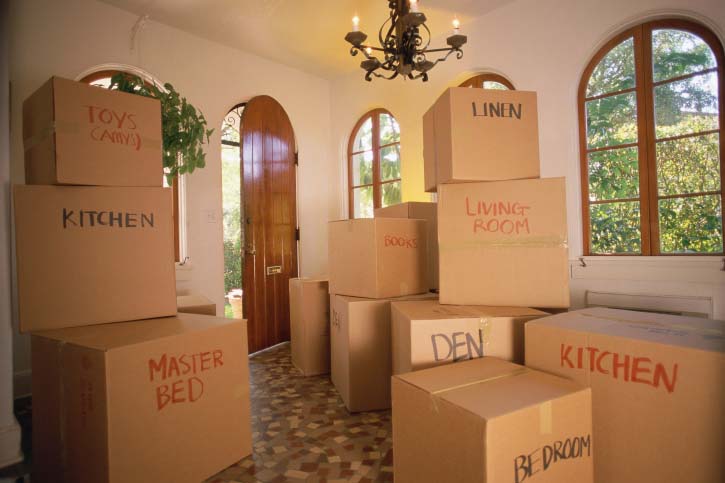Moving Storage Supplies for Your Move-In
EZ Storage® can help you save money! Some of our self-storage locations stock a variety of moving and packing supplies for your convenience, including locks, boxes, tape, bubble wrap, mattress covers, and shelving. These are just some of the moving necessities you can purchase on-site, and with the right supplies, you can make the move into your storage unit much, much easier!

The safest way to pack
When packing, whether you’re moving a one-bedroom apartment or an entire house, it’s important to make sure you stay safe while you do it. Here are a few key tips for making sure you pack your home up in the safest way possible.
- Remove clutter. If your home feels messy and the process feels rushed and stressful, you’re more likely to make unsafe decisions and other mistakes.
- Pack smartly. Make sure you reinforce the bottom of your boxes with tape, and don’t overstuff them — one person should be able to lift each box safely.
- Use the right materials. Plan ahead and get your packing materials in advance, and make sure you’re using the best possible materials.
- Avoid packing harmful materials. Anything generally hazardous, including heavy-duty cleaning supplies, can create a dangerous mess in the moving process. Try not to pack anything you wouldn’t be comfortable making skin contact with.

Best Packing Materials
The good news is there are plenty of great packing materials that are easy to access and will get the job done. Below, we’ve listed some of the best packing materials you can use, and where they’ll come in handy.
- Tissue Paper. Tissue paper is probably too thin to provide much cushion or shock absorption, but it’s a useful thing to wrap around metal fixtures to keep them from rubbing against wood or glass while they are in storage.
- Packing Paper. Packaging paper is better for fragile items, though it shouldn’t be the only packaging that you use. This is useful stuff if you need to fill up a box that has some extra room in it; this will prevent the fragile item from moving around inside the too-large box.
- Newspaper. If you just need a little extra padding and don’t want to shell out the money for packing paper, you can use newspaper to fill up your boxes or as an outside layer to an item that’s already been wrapped.
- Plastic Wrap. Plastic wrap is a lifesaver when it comes to moving fragile items. While it’s true that it doesn't provide a great deal of shock absorption, it’s perfect for keeping items in place while the piece is in transit.
- Bubble Wrap. This is hands down our top recommended packing material for fragile items. Bubble wrap provides plenty of shock absorption, reducing the risk of your fragile items being damaged if they are jostled or dropped.
Moving and Packing 101 Tips
Setting the stage for a trouble-free move starts with a few organizational tips designed to rein-in the details and cover all the bases. Advanced planning eliminates the stress and keeps you on target meeting moving deadlines.
- Define Your Approach. There are a number of ways to go about moving, each requiring different levels of effort from you and your family. You can hire a moving company to box-up your belongings and handle the whole move, or rent a truck and do it all yourself. Knowing what you want to do will make the planning process easier.
- Establish Timelines. Creating a timeline is a prudent first step toward getting the job done. Use an eight-week schedule to prioritize and break your moving effort into manageable chunks.
- Settle on a Mover. Certain times of year tax movers’ availability, so one of your first endeavors is to contact several moving companies to request competitive bids. Draw the line where you see fit, but don’t go with the first carrier you look at. With no other pricing reference points, you may end up paying too much for your move.
- Evaluate Your Possessions. Evaluate your possessions several weeks ahead of your moving date, with an eye toward purging unwanted items. This also provides the perfect opportunity to donate unused household goods to charity resale shops.
- Prepare to Pack. Acquire packing materials with weeks to spare, allowing family members to begin filling boxes well ahead of your moving date.
For a full list of packing tips, check out our Packing Tips for Moving Guide.
Frequently Asked Questions
Below, we’ve brought together answers to some frequently asked questions about moving and packing supplies.
What should I use for packing materials?
Cardboard boxes, plastic tubs, wrapping paper, plastic wrap, newspaper, bubblewrap, and tissue paper are all common and excellent packing materials that will help keep your belongings safe while moving.
What is a standard moving box size?
Medium boxes, which typically run 18 x 18 x 15 inches, are the most common moving box. The size is perfect for records, toys, small appliances, office supplies, and most common household items.
What box size do I need?
To figure out what box size you need, you’ll need to know the dimensions of what you’re trying to pack. Measure the item you’re going to pack at its longest, widest, and tallest points to determine the dimensions of the box that you’ll need.
What size box is best for moving books?
Books are a lot heavier than you think, which is why it’s a good idea to keep it small when packing. Typically, the best book box is a small one, for instance, a 1.5-cubic-foot box, or even smaller.